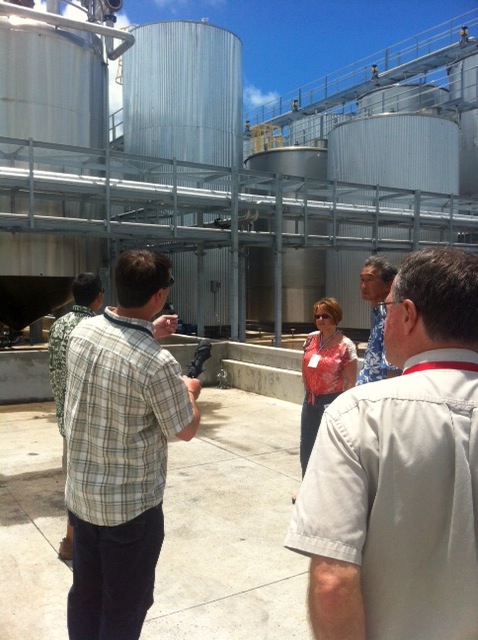Richard Ha writes:
Big Island Biodiesel had its grand opening last week, and I took a tour of its facility.
I have been a long-time supporter of its business model. It works.
Now, with the help of the UH College of Tropical Agriculture and Human Resources (CTAHR), as well as the Pacific Basin Agricultural Research Center and others, farmers can start to think about what crops might be profitably grown to make biofuels.
From a Civil Beat article:
Richard Ha, owner of Hamakua Springs Country Farms, who has been a vocal critic of biofuels in the past, was optimistic about the plant.
“They have the best business model to make it work,” he said. “And the reason for it is this facility is paid for . . . So when they come and talk to the farmers it doesn’t rest only on the farmers. They already have the business model.”
But he did say that it wasn’t without challenges for the farmer.
He broke it down this way:
Big Island farmers sell hay for $70 — $75 per 500 pound bale. That is $280 to $300 per ton. On the mainland the folks who were planning to make cellulosic biofuels needed it for $45 per ton. But, the farmers were getting $100 per ton for hay. So, they got a $45 per ton subsidy.
Beside the feedstock gap, the farmer will need to pay for something to squeeze the oil out of the sunflower. So, the obstacle to get over is quite high. Read the rest here.


They have a real challenge ahead to show biodiesel is cost competitive with diesel from the pump. In the case of the US Navy, their effort resulted in biodiesel costing about $26 per gallon, about 5 times the price at the pump. The senate got fed up with it and cut the Navy off. This article unfortunately describes biodiesel as biofuel, when the subsidy problem is specific to biodiesel. The problem is that biodiesel biofuel has to be distilled to be useable and that takes energy, so far, more energy than the cost of diesel at the pump:
http://www.wired.com/dangerroom/2012/05/senate-cuts-off-navy-biofuel/
Senate Panel Cuts Off Navy’s Biofuel Buys
Biodiesel is made to sound cool by sticking a bio in front but it is still diesel. The media likes to rave about it being able to use the waste grease from restaurants. So, does that mean I can go down, get a bucket of used grease from the KFC and pour that into the Mercedes Benz diesel tank? Nope. Biodiesel has to be distilled from the grease and feedstock. That takes a lot of power to distill, and so far, this cost to distill pushes the cost of biodiesel far above the pump price. That feedstock has to get to the plant somehow, with trucks, probably getting less than 10 miles per gallon. Then it needs to be ground up with machinery that is using a lot of electricity. It probably needs to be fermented under heat and maybe they are using the sun for that. Meaning to go down and see how they are getting the heat to distill. If it is electric (don’t think it can be gas), then it will be another example of HELCO rates are affecting industrial, as well as farming, business around here.
Very good point punated, paying very close attention too how this is going to play out, I’ve talked to the people of Pacific, I am highly impressed with their model. On a side note the ranchers do not want GMO stock so Pacific has made the business decision to not put their hands in that pot.